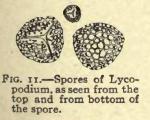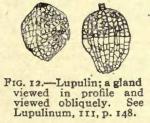Low plants looking like very large mosses, more or less branching, and with the 1- to 3-celled sporangia (spore-cases) in the axils of the lanceolate, subulate, or rounded, persistent leaves. Spores homogeneous.
18. Lycopodium.—Lycopodium. Vegetable sulphur.
The spores of Lycopo'dium clava'tum Linné, and of other species of Lycopodium.
BOTANICAL CHARACTERISTICS.—Stem creeping extensively, with ascending very leafy branches. Leaves linear-awl-shaped, aristate. Spikes 1 to 4 on a slender peduncle 4 to 6 inches long.
SOURCE AND COLLECTION.—Europe, Asia, and North America; collected mostly in Russia, Germany, and Switzerland, in July and August, by cutting off tops of the moss, shaking out spores, and sifting.
DESCRIPTION OF DRUG.—A fine, pale-yellowish powder, very mobile, free from odor and taste. It floats in water without being wet by it (due to the fixed oil), but sinks on being boiled. When slowly heated it burns quietly and should not leave more than 5 per cent. of ash, but when thrown into a flame it flashes up. Under the microscope the granules are seen to be tetrahedral, the basal side convex and the other three coming together to form a triangular pyramid. The surfaces are traversed in all directions by ridges which form regular, five- or six-sided meshes; at the points of intersection are small elevations, and along the edges short projections. Like lupulin, lycopodium is one of the interesting objects for microscopic study. Pollen of pine, an illustration of which is shown above, is sometimes used as an adulterant.
ADULTERANTS.—These may be easily detected by the microscope or simple tests. Pine pollen consists of an elliptical cell with a globular cell attached to each end. Starch is detected with iodine; turmeric, by turning reddish-brown with alkalies; inorganic mixtures, by increasing the yield of ash over 5 per cent., and by sinking in carbon disulphide. Dextrin has been found in lycopodium to the extent of 50 per cent.
Powder.—Microscopical elements of: See Part iv, Chap. I, B.
CONSTITUENTS.—Fixed Oil 47 to 50 per cent., volatile bases in very small quantity, and ash containing alumina and phosphoric acid, not exceeding 3 per cent.
ACTION AND USES.—Absorbent and protective application to excoriated surfaces; in pharmacy, to facilitate the rolling of pill masses, and to prevent the adhesion of the pills.




